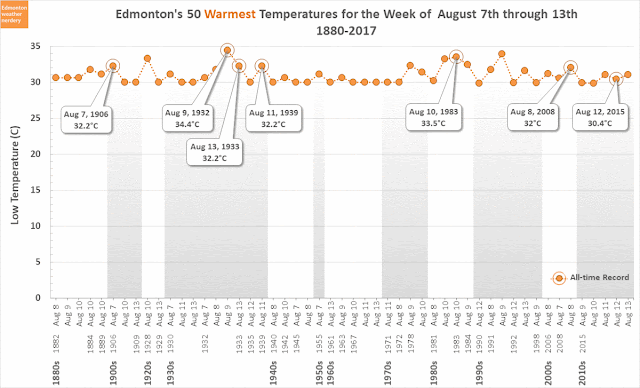Edmonton's 30°C Days
This chart is an old one from Edmonton's Hottest Days, but it's a nice indication of how often/rarely Edmonton gets 30°C days.
And for the really hot 35°C days, since 1880 Edmonton has recorded:
- one 37°C day: June 29th, 1937 at 37.2°C
- one 36°C day: July 2nd, 1924 at 36.7°C
- three 35°C days: July 1st, 1924 at 35.6°C; July 3rd, 1924 at 35°C; and August 18th, 1933 at 35.6°C
Those were all more than 80 years ago. In recent years we've hit 34°C in 2015, 2008, 2006 and twice in 2002.
August 8th
Here we have the history of Highs & Lows for August 8th, going back to 1880. Edmonton's warmest recorded August 8th occurred fairly recently in 2008, with a High of 32°C.
August 9th
In comparison, for August 9th the record was set way back in 1932 at 34.4°C.
August 10th
And August 10th's record was set back in the not-too-distant 1983, at 33.5°C.
Top 50 for the week of August 7-13
If we look the 50 warmest temperatures for this week as a whole, most of them have been right around the 30°C mark, with a few pushing up to 32°C or 34°C. The warmest record for this week is August 9th at 34.4°C, and the coldest is August 12th at 30.2°C.
The grey shading in this chart breaks things out be decade, and the 1930's are the leader with 9 days in the Top-50. The 1990's had 6 days, spread across 4 years: 1990, 1991, 1992 and 1998. So far the 2010's have only had one year with any days in the Top-50, but that was 2015 which had a 5-day heatwave.






So, growing up, I always had the sense that 30-degree days were rare, and it was only after I moved to Montreal that I really started to experience them on a regular basis. When talking to someone about the heatwaves recently, I said that I was pretty sure I saw more -40C days than 30C days while I was in Edmonton. (So, about 1980 to 2008.) Do you reckon that’s true, or am I just misremembering the heat of the summers?
ReplyDeleteOn average Edmonton gets about 4 30°C days year, although some years have more and some have less. We looked at that in more detail here:
Deletehttps://edmontonweathernerdery.blogspot.com/2018/05/edmontons-hottest-days.html
On the other hand, Blatchford hasn't recorded any -40°C days since 1972. The International Airport is quite a bit colder, and even it has only recorded 19 days at -40°C in the last 30 years. That averages-out to 0.6/year, but they tend to come in clumps: 2009 had 5, 2003 had 3, 1996 had 3, 1994 had 3. And the airport didn't have any -40°C days from 1980-1988, 1990-1993, 1998-2002, 2006-2007, and then from 2010-today.
That's excluding windchill, although I don't think Environment Canada started reporting things as "feels like..." until relatively recently.
So long story short: 30°C is rare, but -40°C is rarer.
But all that said, in the 90s I remember seeing plenty of temperatures signs (on car dearlerships, funeral homes, etc) that said "-40°C". But looking at the data neither Blatchford nor the International were actually that cold.
This is surprising, but those kind of numbers aren't really subject to interpretation. (I suppose I could broaden the range that's "-40" to account for how we tend to round when talking about temperatures, but that's not really the point.)
DeleteAlso, wind chill is a made-up metric and I don't count it for anything. It's just a way for eastern Canadians to claim that winters here are colder than they are. ;)
Windchill should definitely be mocked.
DeleteBut if we go with -35°C (without windchill) that changes things a bit. Since 1980:
- Blatchford has had 13, or 0.4/winter on average
- the International has had 118, or 3.3/winter
For a long time the media only reported the temperatures from Nisku, and so it was easy to think of Edmonton as being -35°C all the time, even though that was only partly true.
The airport really does get a lot colder than the city (and it's relatively colder than other city's airports, too):
http://edmontonweathernerdery.blogspot.com/2017/03/versus-edmonton-international-airport.html